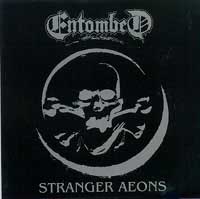Entombed - Stranger Aeons
Review: A transition between the two styles that each indicate a world-view radically different than the other through their use of structure and harmonic contexture in assembling the still-nascent form of death metal from the vantage point of being the most visible progenitors of a new subcategory of the style and ideology of death metal.
Where the first track, "Stranger Aeons," showcases a smooth and consistently energetic interpretation of rock music in the death metal style, the older tracks "Dusk" and "Shreds Of Flesh," while using fragments of riff and structure that would later be applied in radically different construction on the album which bore "Stranger Aeons," emerge from a sequence of rhythmic structures with a compositional style based on a sublimated melody embedded in varying intensities of architecture that serve lucid communicative goals from introduction to counter-theme to revelation. Their elements and style are clearly different, but what is most staggering about this release is to realize how these earlier two tracks express a different intent and thought process than the slick but less-satisfying "Stranger Aeons."
Guitars ride percussive riff patterns to interrupt a melodic progression established through the use of tremelo power chord passages joined with references to a collective structural center, which in a style similar more to thrash bands than to death or speed metal acts serves as a unification for a central motif which emerges in several variations of the same riff, including inversions and semi-retrograde interpretations, often for two or more paradoxically oppositional but structurally harmonizing riffs. The potency of an architecture of rhythmic and melodic fusion supports each song as highly articulate textures of rhythmic lead guitar define each song through moments in which all divergent patterns are unified into a single urgent, possibly even delicate, idea.
For no misbegotten praise was this band celebrated during their time as innovators of style and substance; for the collector or casual viewer, this sidewise glance into a juxtaposition of past and future shows a band at the crux of discovering their own worldview shifting from the nihilistic lucid structures to to a coherence with expectations that despite its ongoing cloak of anger does not address a resolution in the same way the earlier, more abstract works do not fail to.
